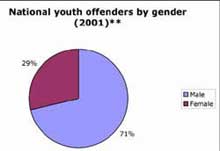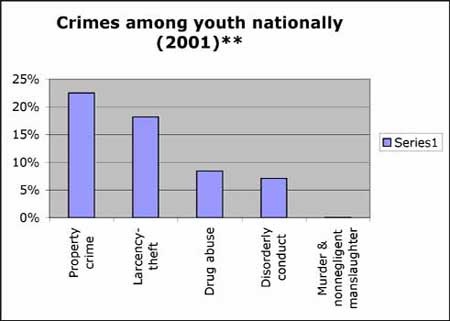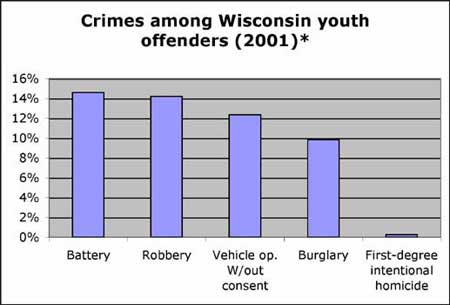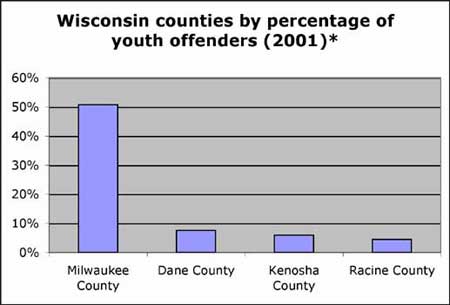By Lindsay Renick Mayer
When many offenders are sentenced to prison, they enter the system with nothing.
No family support. No role models. No feelings of self-worth. Only memories
of a broken home, of a past filled with violence, of their last jail cell and
maybe of a nasty drug habit. After serving their term, they leave the prison
in about the same shape. They leave without hope.
Perhaps this is why Wisconsin state prisons released more than 7,600
men and women last year, but saw 3,087 return on parole revocations.
Perhaps
this is
why about one-third of youthful offenders in Wisconsin commit crimes within
two years of their release. And perhaps this is why the Wisconsin Department
of Corrections’ Division
of Juvenile Corrections (DJC) has established a $2 million “Serious and
Violent Offender Reentry Initiative” that involves entire communities
in the support of youth who have lost their way.
 
The $2 million grant comes from a total of $120 million
awarded to all states except Nebraska (which did not apply for a grant)
from the
U.S. Department
of Justice in partnership with seven other federal agencies. Rather than
target
the re-entry of adult offenders like most other states, the Wisconsin Department
of Corrections decided to use the grant money on juvenile offenders – to
give them hope and a second chance as they “go home.”
“My life has changed since being locked up,” says a 19-year-old Going
Home Project youth from Milwaukee who was incarcerated for sexual assault. “My
life’s on a better track. The project has changed me.”
Transforming lives
The philosophy behind Wisconsin’s Going Home Project for youthful offenders
is a simple one – the shaping of a person’s life is a complex process
and can be greatly influenced by external factors. Every interaction with every
person is important. Every experience leaves a mark. Every memory of these
experiences determines the choices an individual might make.
“The environment plays a large role in shaping behavior,” says Joseph
Newman, professor and director of clinical training at UW-Madison. “This
is especially true for offenders who have fallen into an antisocial lifestyle.
Community
involvement, resources and creative intervention could be very important in
helping youth
released from jail or prison to adopt an alternative lifestyle.” 
The Going Home Project, a three-year re-entry program, takes this
idea and matches existing community services with the specific needs,
strengths and
interests
of 90 youth incarcerated in one of three Wisconsin institutions: Southern
Oaks Girls School in Union Grove, Lincoln Hills School in Irma and
Ethan Allen School
in Wales. Participants in the project are between the ages of 14 and 25 and
have committed serious crimes, ranging from felony murder and sexual assault
to robbery
and arson. Based on a risk assessment that focused on their family life,
their history with drugs and alcohol, past employment and past run-ins
with the law,
the Wisconsin Department of Corrections selected participants considered
likely to re-offend.

Each youth was then matched with one of five re-entry case managers
who develop a “transition team.” This team comprises various
individuals who can provide specific services depending on what the
youth need and request,
including housing, employment, substance abuse counseling, mentoring and family
development.
Individuals from the organizations begin meeting with the youth three months
before their release from prison and continue to meet with them for an average
of six to nine months after their release. These youth offenders are suddenly
bombarded by people concerned with their well being. This may be substantially
different from the world to which they have been exposed.
“These organizations will be there long after we’re gone,” says
Kate Elvidge, director of the Going Home Project. “Once the youth are off,
if we haven’t connected them to people in their own community to help them
go down the right path, we’ve done them an injustice with the time that
we have with them.”
Teaching Life Skills
About 30 organizations have either volunteered their time or have become contractors
for the project. Most draw on volunteers from the community and are simply
extending the resources and programs they already offer. For example, Homeboyz
Consulting
in Milwaukee offers computer training for at-risk youth. The training programs
include lessons on how to build Web sites, use software like Photoshop and
write HTML code. Upon completion, the trainee is offered a permanent job with
the consulting
firm, building Web sites for a variety of clients. Going Home Project youth
are taking advantage of this service and finding themselves employed full-time,
usually
for the first time.
Another Milwaukee-based organization, New Outlook, houses up to eight juvenile
offenders who have no other place to go. Robb Taylor, program director, helps
the youth find employment or places them in school. He also brings in volunteers
from the community who have been victimized. The victims voluntarily speak
to the youth about their experiences, while the youth are encouraged to speak
openly
about their past.
“I think that most of the time we send these kids back into the community
without the tools they need to be a focal part of the community,” Taylor
says. “If
you think about it, you know the old stuff better than the new stuff. We just
need people with the will to help these kids. Otherwise these young people
just give up.”
In addition to teaching participants about critical thinking, responsibility
and decision-making, the Going Home Project also works on family connections.
Both the Parenting Network and the Alternatives to Psychological Consultation
play pivotal roles in strengthening the relationship between youth and their
families. Family members are encouraged to visit the youth while he or she
is incarcerated and to get involved in role-playing activities and open discussions
about the future. The Parenting Network has recently initiated programs in
two
Milwaukee neighborhoods open for all families who may be concerned with the
well being of their children. Going Home Project families are invited to attend.
“We have real high hopes that this will help families bond and learn from
each other,” Jan Buchler, director of the Parenting Network, says. “That
kind of learning is indispensable. As a community gets healthier, the lessons
will filter down. So if your own parents aren’t capable of guiding you,
maybe your aunt two blocks down or your next door neighbor will have some positive
influence.”
It Takes a Community
The use of a wide range of community services ensures that every positive aspect
of the youth’s life be strengthened. Advocates do not yet know how successful
this method will be in preventing second or third offenses because it is the
first program of its kind implemented in Wisconsin. According to Elvidge, success
will be defined by how much the quality of life has improved for the participants – this
means higher literacy levels, steady employment or school attendance, housing
and abstinence from drugs and alcohol. And, of course, the project will clearly
succeed if the youth stay out of prison and become contributing
members of society.
“Especially in Milwaukee County, they see so many unfortunate things happen
to our youth and I think people are sick of it and they want to do something
about
it,” says re-entry case manager, Kim Langrehr. “When community
members help these youth, they are benefiting the entire community.”

Similar programs in other states have shown that this type of re-entry
does positively change the lives of these youth, as well as the communities
in which
they live.
The Going Home Project was modeled after the Intensive Aftercare Program, developed
by Dr. David Altschuler at Johns Hopkins University and Dr. Troy Armstrong
at California State University – Sacramento. This program, funded by
the U.S. Department of Justice Office of Juvenile Justice and Delinquency Prevention,
lasted seven years and targeted youth offenders in Colorado, Nevada and Virginia
and employed a similar strategy of drawing on the entire community to meet
the
needs of the youth.
“The success of such a program is something that we are still studying
closely and carefully examining,” Altschuler says. “And if we don’t
get the results we had hoped for, we have to find ways to make this kind of
program better.”
Some are, indeed, skeptical that the results will be positive and believe that
the money would be better spent on adult offenders or on at-risk youth before
their first incarceration. Others believe that $2 million from the federal
government simply isn’t enough. According to Steve Sawyer, outpatient
program manager for the Alternatives to Psychological Consultation, it is difficult
to effectively
intervene when it comes to the lives of youth offenders.
But those involved in the Going Home Project, which only began in July 2002,
are already speaking highly of it.
“This is the best thing that’s ever happened to me,” a 17-year-old
project participant from West Allis says. “I’ve gotten a job, I’m
doing community service and I’m back at home. Someday I’d like
a home of my own. A car, maybe. A family. I might try to get a degree in business.
So far, so good.”
If this type of success becomes the rule, rather than the exception, Elvidge
hopes that when the grant money runs out in June 2005, the Wisconsin Department
of Corrections’ Division of Juvenile Corrections will continue to practice
what the project has modeled and more organizations will volunteer their help.
In this way, these youth who may have felt like they had nothing, gain something.
Gain hope.
“
Hope plays a role in everyone’s life,” Peter Marik, re-entry case
manager for the Going Home Project, says. “It is what keeps people going.
It is why you make the decisions you do. If you have hope, you care about what
the outcome of your actions will be. I think this project gives the youth hope.
It is something different.”
If you are interested in volunteering for the Going Home Project, contact:
Kate Elvidge
Director, Going Home Project
608-240-5937
kate.elvidge@doc.state.wi.us
*Statistics from the Wisconsin Division of Corrections
**Statistics from the Sourcebook of Criminal Justice Statistics
For more information, visit the following sites:
Wisconsin Going
Home Project: This site offers more information about the Going
Home Project and how to become involved with this youth offender re-entry program.
Office of Juvenile
Justice and Delinquency Prevention Aftercares Services Bulletin:
This bulletin provides the most current research results for the Intensive
Aftercare Program, the program after which the Going Home Project was modeled.
Wisconsin
Youth Program Directory: Although this program is not associated
with the Going Home Project, mentoring is a great way to help at-risk youth.
This link offers detailed information about how to get involved in this program
in your particular county.
|










